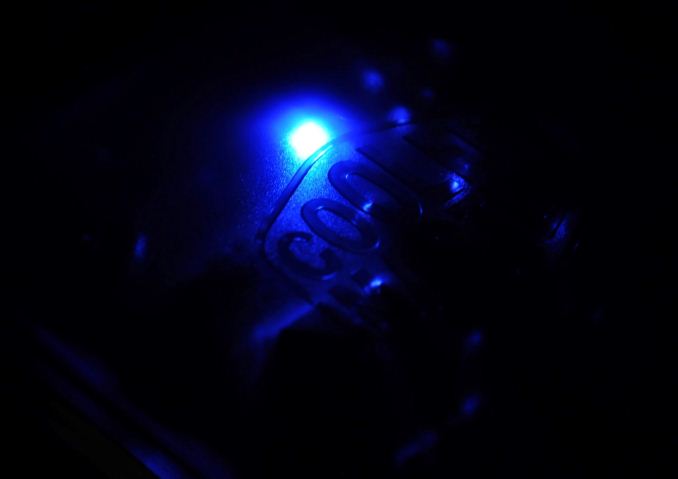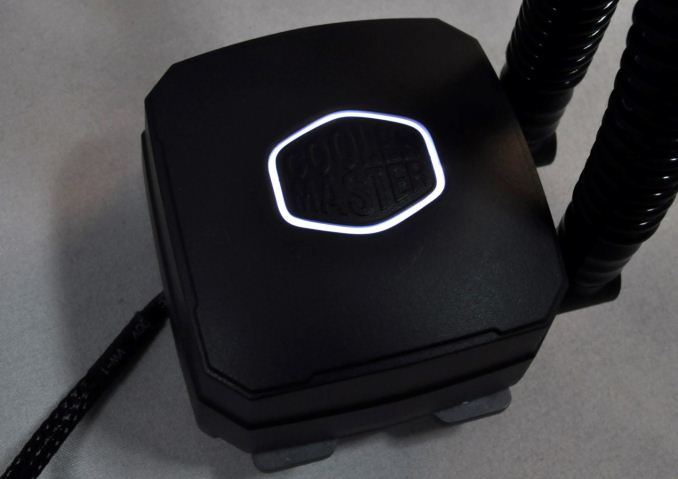Closed Loop AIO Liquid Coolers: 14-way Mega Roundup Review
by E. Fylladitakis on February 12, 2014 7:00 AM ESTCooler Master
Cooler Master is a company with a tradition of cooling-related products and thus it is no wonder that they jumped into the AIO liquid coolers wagon almost instantly. They have a healthy selection of products and decided to ship us their two Nepton series coolers, their most popular series at this point in time, along with the Seidon 120V, a very low cost, entry level solution.
Cooler Master Seidon 120V
The Cooler Master Seidon 120V is the smallest, simplest and least expensive AIO cooler of this review. The packaging reflects that, being a relatively simple brown cardboard box, unlike any other in this particular roundup. Looks aside, the packaging is well designed, full of information on the cooler, and the cooler is very well protected inside the cardboard packaging.
Inside the box, the user will find a leaflet with installation instructions, the necessary mounting hardware, and a syringe with thermal compound. Also included is a single 120mm fan with a wide speed range of 600 to 2400 RPM; it is an all-black model with wavy blades.
Both technically and aesthetically, the Cooler Master Seidon 120V is a rather simple design. The 27mm thick, 120mm wide radiator is the smallest and least expensive design available today. Wavy aluminum fins are formed between the liquid pass-through channels, which are not dense but not sparse either. There are imperfections in the fins but these are to be expected with a low-cost radiator.
The square block-pump assembly is entirely made out of plastic, which is not bad in terms of durability but gives a feeling of cheapness. The company logo is etched on the top of the block and a bright blue LED turns on when the pump is powered on. Only the base of the block is made out of copper, which is expected given the price. This copper base has been attached to the rest of the assembly with the aid of ten triangular screws and has a smooth, well-machined surface, although it has not been machined down to a mirror finish. The tubing is corrugated and a little hard to bend but at least the fixing points on the CPU block assembly are rotatable sideways.
Cooler Master Nepton 140XL
Unlike the basic 120V, the Nepton 140XL is a significantly more sophisticated, detailed product. It does however cost twice as much as the 120V. It comes supplied in a carefully designed black-purple cardboard box, well protected inside cardboard packaging.
The bundle is not much different than above, limited to the necessary mounting hardware, a leaflet with installation instructions, and a syringe of thermal compound; a Y-splitter for the attachment of two fans onto one header is also included. Two powerful 140mm fans come with the cooler, with a speed range of 800 to 2000 RPM. These "Jetflo" fans are supposed to have high static pressure and the rubber pads absorb vibrations, reducing noise.
Visually, the Nepton 140XL is not much different from the Seidon 120V. Technically, the two coolers are nothing alike. The 140mm radiator of the Nepton 140XL is not only wider but is also 38mm deep, increasing the effective heat dissipation surface by well over 50%. Size aside, the design of the radiator is similar, with wavy aluminum fins between the heat exchanging channels and with a frame offering the ability to mount either 120mm or 140mm fans on it. However, it would seem that manufacturing imperfections are still present, with several of the fins significantly deformed. It appears as if the radiator was struck with something, deforming half a channel of fins, yet we received the packaging in excellent condition and this side of the radiator was facing inwards, towards the center of the packaging. Quality control issues in Cooler Master's manufacturing paradise are the only reasonable guess we can make -- that or the cooler was previously tested and repackaged for our review, though that seems unlikely.
The square block-pump assembly is once again entirely made out of plastic. Even though it looks much better and of higher quality than that of the 120V, plastic rarely is the way to go when you want a worthwhile aesthetic outcome. The company logo is etched on the top of the block and is surrounded by a frame with a white LED, which turns on when the pump is powered up. A plastic frame is sandwiched between the cap and the base of the assembly, with holes for the mounting of the installation brackets. The copper base of the assembly is smooth but not machined perfectly; although they cannot be felt by touch, the sandpaper grooves are clearly visible with a naked eye.
Cooler Master Nepton 280L
The Nepton 280L is Cooler Master's heavy artillery. We received it supplied inside a well-designed cardboard packaging with a black/purple color theme, visually very similar to that of the 140XL. The main attraction of the kit, the large 280mm radiator, dominates the theme of the box. Inside the box, with the exception of a slightly different installation instructions leaflet, we found the exact same bundle as that of the 140XL, including two of the same 140mm "Jetflo" fans.
The Cooler Master Nepton 280L might appear like an oversized version of the 140XL but it really is not. They do share many similarities but the main part of the kit, the radiator, is very different. The radiator of the 280L, as the name suggests, is 140mm wide and 280mm long, with room for up to four 140mm fans. The frame also offers support for 120mm fans, if the user would like to use 120mm fans instead for whatever reason. However, the radiator of the 280L is only 30mm thick, which is about 25% less than that of the 140XL. Therefore, although the heat dissipation surface is greater, it is not actually double that of the 140XL. Once again, minor deformations of the aluminum fins can be seen, although not nearly as many or as serious as those we encountered on the 140XL.
The square block-pump assembly is entirely identical to that used by the 140XL as well. It features the exact same size, mounting mechanism, pump, core and everything else. The same white LED lighting frame at the top of the block has also been installed. Unfortunately, the same mediocre copper base is also present, which could use a little bit better polishing for a product of this league and price range.






























139 Comments
View All Comments
thewhat - Wednesday, February 12, 2014 - link
"the Corsair H90 ... is entirely silent when its fan's voltage is reduced down to 7 Volts."I've tried some of the quietest fans in existence and at 920 rpm they weren't even quiet, let alone entirely silent.
Anything over 600-700 rpm is usually audible, but quiet. And at around 800 rpm it stops being quiet.
Maybe we just have different standards for quietness.
But then liquid cooling was never a good option for silence freaks, anyway.
E.Fyll - Wednesday, February 12, 2014 - link
There are great differences between fans, even at same RPM, depending on their engine and wing design. This is also being displayed in this review, as fans running at nearly the same RPM have vast performance differences. At one meter away, I could not possibly discern any noise coming from the H90, that is why I classified it as silent. If however you were to install it inside a metallic case with many openings, which would reflect and enhance the noise level, you might be able to notice a low-tone humming noise - that's a maybe, a mere assumption on my part.Aikouka - Wednesday, February 12, 2014 - link
I don't know if anyone else considers it to be worthwhile, but I wouldn't mind seeing how well these coolers work when you remove one of the commonly-changed variables: the fans. I rarely ever use stock fans, and along those lines, it would be interesting to see what would happen if the same fans (per standard size -- 120mm and 140mm) were used on each cooler.jjj - Wednesday, February 12, 2014 - link
Pretty pointless without a comparison with the same fans and some air coolers.silenceisgolden - Wednesday, February 12, 2014 - link
I'm a little disappointed that patent trolls kept the Swiftech offerings from this list, but that's how things are I guess.casteve - Wednesday, February 12, 2014 - link
Thanks for the review. What was the ambient noise level and the noise meter used for the test?E.Fyll - Wednesday, February 12, 2014 - link
My apologies, I should have added this into the review. Will do so from now on. The meter is an Extech HD600 and the background noise level is 30.4 dB(A) (+/- about 0.5 dB(A), depending on the night I perform a test).casteve - Wednesday, February 12, 2014 - link
Thanks. As this meter has a lower limit of 30dB(A) and an accuracy of +/-1.4dB, your ambient is probably quieter and you are just seeing the low end of what the meter can do. Sort of expected unless (as you say) you have an expensive set up for the test equipment. Get Anand to shill out the $'s for a 10dBA microphone and an anechoic chamber for that spare bedroom. :)Some terms - if the meter is reading sound pressure level, then it's dB(A) SPL, which is referenced to 20 micro Pascals (0 dB). So, 0 dB(A) SPL is the threshold of hearing, 20-30dB(A) SPL is a calm room.
pcfxer - Wednesday, February 12, 2014 - link
All of these are way too loud. At 30+ dB, none of these coolers hit the envelope for someone who actually cares about "silence" and noise.E.Fyll - Wednesday, February 12, 2014 - link
You are confusing dB and dB(A), I am afraid. The background noise of my room at 2:00AM is 30.4 dB(A). Sub-35 dB(A) levels are generally impossible to notice by a human ear. Sub-30 dB(A) levels are next to impossible to record with anything less than science lab-grade equipment. There is no handheld or desktop dB(A) meter that can perform such readings. If you have seen reviews stating sub-30 dB(A) levels, make sure to check their methodology (given that there is any). Either the meter cannot read lower than 30 dB(A) (and/or will display a bogus reading, as most cheap Chinese meters do) and the review is a fictional text or their methodology is based on dB readings, not dB(A) readings, which is useless to a consumer.